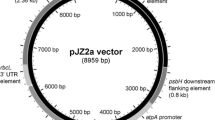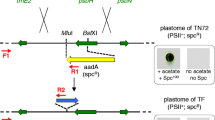Abstract
Recombinant proteins have become more and more important for the pharmaceutical and chemical industry. Although various systems for protein expression have been developed, there is an increasing demand for inexpensive methods of large-scale production. Eukaryotic algae could serve as a novel option for the manufacturing of recombint proteins, as they can be cultivated in a cheap and easy manner and grown to high cell densities. Being a model organism, the unicellular green alga Chlamydomonas reinhardtii has been studied intensively over the last decades and offers now a complete toolset for genetic manipulation. Recently, the successful expression of several proteins with pharmaceutical relevance has been reported from the nuclear and the chloroplastic genome of this alga, demonstrating its ability for biotechnological applications.
Similar content being viewed by others
References
Johnson, I. S. (1983) Human insulin from recombinant DNA technology. Science 219, 632–637.
Walsh, G. (2003) Biopharmaceutical benchmarks-2003. Nat. Biotechnol. 21, 865–870.
Walsh, G. (2004) Secod-generation biopharmaceuticals. Eur. J. Pharm. Biopharm. 58, 185–196.
Robinson, K. (2002) An industry comes of age. Biopharm. Int. 15, 20–24.
Werner, R. G. (2004) Economic aspects of commercial manufacture of biopharmaceuticals. J. Biotechnol. 113, 171–182.
Lorenz, P. and Eck, J. (2005) Metagenomics and industrial applications. Nat. Rev. Microbiol. 3, 510–516.
Garber, K. (2001) Biotech industry faces new bottleneck. Nat. Biotechnol. 19, 184–185.
Gao, B. and Tsan, M. F. (2003) Endotoxin contamination in recombinant human heat shock protein 70 (Hsp70) preparation is responsible for the induction of tumor necrosis factor alpha release by murine macrophages. J. Biol. Chem. 278, 174–179.
Cereghino, J. L. and Cregg, J. M. (2000) Heterologous protein expression in the methylotrophic yeast Pichia pastoris. FEMS Microbiol. Lett. 24, 45–66.
Franklin, S. E. and Mayfield, S. P. (2004) Prospects for molecular farming in the green alga Chlamydomonas. Curr. Opin. Plant Biol. 7, 159–165.
Maga, E. A. (2005) Genetically engineered livestock: closer than we think? Trends Biotechnol. 23, 533–535.
Kost, T. A., Condreay, J. P., and Jarvis, D. L. (2005) Baculovirus as versatile vectors for protein expression in insect and mammalian cells. Nat. Biotechnol. 23, 567–575.
Fischer, R. and Emans, N. (2000) Molecular farming of pharmaceutical proteins. Transgenic Res. 9, 279–299.
Quist, D. and Chapela, I. H. (2001) Transgenic DNA introgressed into traditional maize landraces in Oaxaca, Mexico. Nature 414, 541–543.
Rieger, M. A., Lamond, M., Preston, C., Powles, S. B., and Roush, R. T. (2002) Pollen-mediated movement of herbicide resistance between commerical canola fields. Science 296, 2386–2388.
Leon-Banares, R., Gonzalez-Ballester, D., Galvan, A., and Fernandez, E. (2004) Transgenic microalgae as green cell-factories. Trends Biotechnol. 22, 45–52.
Franklin, S. E. and Mayfield, S. P. (2005) Recent developments in the production of human therapeutic proteins in eukaryotic algae. Expert Opin. Biol. Ther. 5, 225–235.
Walker, T. L., Purton, S., Becker, D. K., and Collet, C. (2005) Microalgae as bioreactors. Plant Cell Rep. 24, 629–641.
Mayfield, S. P. and Franklin, S. E. (2005) Expression of human antibodies in eukaryotic micro-algae. Vaccine 23, 1828–1832.
Hawkins, R. L. and Nakamura, M. (1999) Expression of human growth hormone by the eukaryotic alga, Chlorella. Curr. Microbiol. 38, 335–341.
Cohill, P. R. and Cannons, A. C. (2001) Transgenic Chlorella as a phytoremedial bioreactor. FASEB J. 15, A877.
Kim, D.-H., Kim, Y. T., Cho, J. J., et al. (2002) Stable integration and functional expression of flounder growth hormone gene in transformed microalga, Chlorella ellipsoidea. Marine Biotechnol. 4, 63–73.
Sun, M., Qian, K., Su, N., Chang, H., Liu, J., and Chen, G. (2003) Foot-and-mouth disease virus VP1 protein fused with cholera toxin B subunit expressed in Chlamydomonas reinhardtii chloroplast. Biotechnol. Lett. 25, 1087–1092.
Mayfield, S. P., Franklin S. E., and Lerner, R. A. (2003) Expression and assembly of a fully active antibody in algae. Proc. Natl. Acad. Sci. USA 100, 438–442.
Borovsky, D. (2003) Trypsin-modulating oostatic factor: a potential new larvicide for mosquito control. J. Exp. Biol. 206, 3869–3875.
Harris, E. H. (2001) Chlamydomonas as a model organism. Annu. Rev. Plant Physiol. Plant Mol. Biol. 52, 363–406.
Haris, E. H. (1989) The Chlamydomonas Sourcebook: A Comprehensive Guide to Biology and Laboratory Use. Academic Press, Inc., San Diego, CA.
Fuhrmann, M. (2002) Expanding the molecular toolkit for Chlamydomonas reinhardtii: from history to new frontiers. Protist. 153, 357–364.
Shrager, J., Hauser, C., Chang, C. W., et al. (2003) Chlamydomonas reinhardtii genome project. Aguide to the generation and use of the cDNA information. Plant Physiol. 131, 401–408.
Im, C. S., Zhang, Z., Shrager, J., Chang, C. W., and Grossman, A. (2003) Analysis of light and CO2 regulation in Chlamydomonas reinhardtii using genomewide approaches. Photosyn. Res. 75, 111–125.
Eberhard, S., Jain, M., Im, C. S., et al. (2005) Generation of an oligonucleotide array for analysis of gene expression in Chlamydomonas reinhardtii. Curr. Genet. 49, 106–124.
Fuhrmann, M., Stahlberg, A., Govorunova, E., Rank, S., and Hegemann, P. (2001) The abundant retinal protein of the Chlamydomonas eye is not the photoreceptor for phototaxis and photophobic responses. J. Cell Sci. 114, 3857–3863.
Rohr, J., Sarkar, N., Balenger, S., Jeong, B. R., and Cerutti, H. (2004) Tandem inverted repeat system for selection of effective transgenic RNAi strains in Chlamydomonas. Plant J. 40, 611–621.
Zorin, B., Hegemann, P., and Sizova, I. (2005) Nucleargene targeting by using single-stranded DNA avoids illegitimate DNA integration in Chlamydomonas reinhardtii. Eukaryot. Cell 4, 1264–1272.
Takahashi, Y., Goldschmidt-Clermont, M., Soen, S. Y., Franzen, L. G., and Rochaix, J. D. (1991) Directed chloroplast transformation in Chlamydomonas reinhardtii: insertional inactivation of the psaC gene encoding the iron sulfur protein destabilizes photosystem I. EMBO J. 10, 2033–2040.
Kindle, K. L. (1990) High-frequency nuclear transformation of Chlamydomonas reinhardtii. Proc. Natl. Acad. Sci. USA 87, 1228–1232.
Dunahay, T. G. (1993) Transformation of Chlamydomonas reinhardtii with silicon carbide whiskers. Biotechniques 15, 452–460.
Tang, D. K., Qiao, S. Y., and Wu, M. (1995) Insertion mutagenesis of Chlamydomonas reinhardtii by electroporation and heterologous DNA. Biochem. Mol. Biol. 36, 1025–1035.
Shimogawara, K., Fujiwara, S., Grossman, A., and Usuda, H. (1998) High-efficiency transformation of Chlamydomonas reinhardtii by electroporation. Genetics 148, 1821–1828.
Debuchy, R., Purton, S., and Rochaix, J. D. (1989) The argininosuccinate lyase gene of Chlamydomonas reinhardtii: an important tool for nuclear transformation and for correlating the genetic and molecular maps of the ARG7 locus. EMBO J. 8, 2803–2809.
Boynton, J. E., Gillham, N. W., Harris, E. H., et al. (1988) Chloroplast transformation in Chlamydomonas with high velocity microprojectiles. Science 240, 1534–1538.
Stevens, D. R., Rochaix, J. D., and Purton, S. (1996) The bacterial phleomycin resistance gene ble as a dominant selectable marker in Chlamydomonas. Mol. Gen. Genet. 251, 23–30.
Davies, J. P., Weeks, D. P., and Grossman, A. R. (1992) Expression of the arylsulfatase gene from the beta 2-tubulin promoter in Chlamydomonas reinhardtii. Nucleic Acids Res. 20, 2959–2965.
Schroda, M., Blocker, D., and Beck, C. F. (2000) The HSP70A promoter as a tool for the improved expression of transgenes in Chlamydomonas. Plant J. 21, 121–131.
Quinn, J. M., Kropat, J., and Merchant, S. (2003) Copper response element and Crrl-dependent Ni (2+)-responsive promoter for induced, reversible gene expression in Chlamydomonas reinhardtii. Eukaryot. Cell 2, 995–1002.
Loppes, R., Radoux, M., Ohresser, M. C., and Matagne, R. F. (1999) Transcriptional regulation of the Nia1 gene encoding nitrate reductase in Chlamydomonas reinhardtii: effects of various environmental factors on the expression of a reporter gene under the control of the Nial promoter. Plant Mol. Biol. 41, 701–711.
Mayfield, S. P. and Schultz, J. (2004) Development of a luciferase reporter gene, luxCt, for Chlamydomonas reinhardtii chloroplast. Plant J. 37, 449–458.
Franklin, S., Ngo, B., Efuet, E., and Mayfield, S. P. (2002) Development of a GFP reporter gene for Chlamydomonas reinhardtii chloroplast. Plant J. 30, 733–744.
Kindle, K. L., Schnell, R. A., Fernandez, E., and Lefebvre, P. A. (1989) Stable nuclear transformation of Chlamydomonas using the Chlamydomonas gene for nitrate reductase. J. Cell Biol. 109, 2589–2601.
Ferris, P. J. (1995) Localization of the nic-7, ac-29 and thi-10 genes within the mating-type locus of Chlamydomonas reinhardtii. Genetics 141, 543–549.
Nelson, J. A. E., Savereide, P. B., and Lefebvre, P. A. (1994) The CRY1 gene in Chlamydomonas reinhardtii: structure and use as a dominant selectable marker for nuclear transformation. Mol. Cell. Biol. 14, 4011–4019.
Randolph-Anderson, B. L., Sato, R., Johnson, A. M., et al. (1998) Isolation and characterization of a mutant protoporphyrinogen oxidase gene from Chlamydomonas reinhardtii conferring resistance to porphyric herbicides. Plant Mol. Biol. 38, 839–859.
Kovar, J. L., Zhang, J., Funke, R. P., and Weeks, D. P. (2002) Molecular analysis of the acetolactate synthase gene of Chlamydomonas reinhardtii and development of a genetically engineered gene as a dominant selectable marker for genetic transformation. Plant J. 29, 109–117.
Lumbreras, V., Stevens, D. R., and Purton, S. (1998) Efficient foreign gene expression in Chlamydomonas reinhardtii mediated by an endogenous intron. Plant J. 14, 441–447.
Berthold, P., Schmitt, R., and Mages, W. (2002) An engineered Streptomyces hygroscopicus aph 7" gene mediates dominant resistance against hygromycin B in Chlamydomonas reinhardtii. Protist 153, 401–412.
Sizova, I., Fuhrman, M., and Hegemann, P. (2001) A Streptomyces rimosus aphVIII gene coding for a new type phosphotransferase provides stable antibiotic resistance to Chlamydomonas reinhardtii. Gene 277, 221–229.
Goldschmidt-Clermont, M. (1991) Transgenic expression of aminoglycoside adenine transferase in the chloroplast: a selectable marker of site-directed transformation of Chlamydomonas. Nucleic Acids Res. 19, 4083–4089.
Cerutti, H., Johnson, A. M., Gillham, N. W., and Boynton, J. E. (1997) A eubacterial gene conferring spectinomycin resistance on Chlamydomonas reinhardtii: integration into the nuclear genome and gene expression Genetics 145, 97–110.
Bateman, J. M. and Purton, S. (2000) Tools for chloroplast transformation in Chlamydomonas: expression vectors and a new dominant selectable marker. Mol. Gen. Genet. 263, 404–410.
Fuhrmann, M., Oertel, W., and Hegemann, P. (1999) A synthetic gene coding for the green fluorescent protein (GFP) is a versatile reporter in Chlamydomonas reinhardtii. Plant J. 19, 353–361.
Ruiz-Binder, N. E., Geimer, S., and Melkonian, M. (2002) In vivo localization of centrin in the green alga Chlamydomonas reinhardtii. Cell Motil. Cytoskeleton 52, 43–55.
Fuhrmann M., Hausherr, A., Ferbitz, L., Schödl, T., Heitzer, M., and Hegemann, P. (2004) Monitoring dynamic expression of neuclear genes in Chlamydomonas reinhardtii by using a synthetic luciferase reporter gene. Plant Mol. Biol. 55, 869–881.
Minko, I. Holloway, S. P., Nikaido, S., et al. (1999) Renilla luciferase as a vital reporter for chloroplast gene expression in Chlamydomonas. Mol. Gen. Genet. 262, 421–425.
Matsuo, T., Onai, K., Okamoto, K., Minagawa, J., and Ishiura, M. (2006) Real-time monitoring of chloroplast gene expression by a luciferase reporter: evidence for nuclear regulation of chloroplast circadian period. Mol. Cell. Biol. 26, 863–870.
Pulz, O. (2001) Photobioreactors: production systems for phototrophic microorganisms. Appl. Microbiol. Biotechnol. 57, 287–293.
Cerutti, H., Johnson, A. M., Gillham, N. W., and Boynton, J. E. (1997) Epigenetic silencing of a foreign gene in nuclear transformants of Chlamydomonas. Plant Cell 9, 925–945.
Schroda, M. (2005) RNA silencing in Chlamydomonas: mechanisms and tools. Curr. Genet. 49, 69–84.
Barnes, D., Franklin, S., Schultz, J., et al. (2005) Contribution of 5′-and 3′-untranslated regions of plastid mRNAs to the expression of Chlamydomonas reinhardtii chloroplast genes. Mol. Genet. Genomics. 274, 625–636.
Patent application US000006932980.
Cai, X. H., Brown, C., Adhiya, J., Traina, S. J., and Sayre, R. (1999) Growth and heavy metal binding properties of transgenic Chlamydomonas expressing a foreign metallothionein gene. Int. J. Phytorem. 1, 53–65.
Siripornadulsil, S., Traina, S., Verma, D. P., and Sayre, R. T. (2002) Molecular mechanisms of proline-mediated tolerance to toxic heavy metals in transgenic microalgae. Plant Cell 14, 2837–2847.
Patent application US020030022359.
Author information
Authors and Affiliations
Corresponding author
Rights and permissions
About this article
Cite this article
Griesbeck, C., Kobl, I. & Heitzer, M. Chlamydomonas reinhardtii. Mol Biotechnol 34, 213–223 (2006). https://doi.org/10.1385/MB:34:2:213
Issue Date:
DOI: https://doi.org/10.1385/MB:34:2:213




